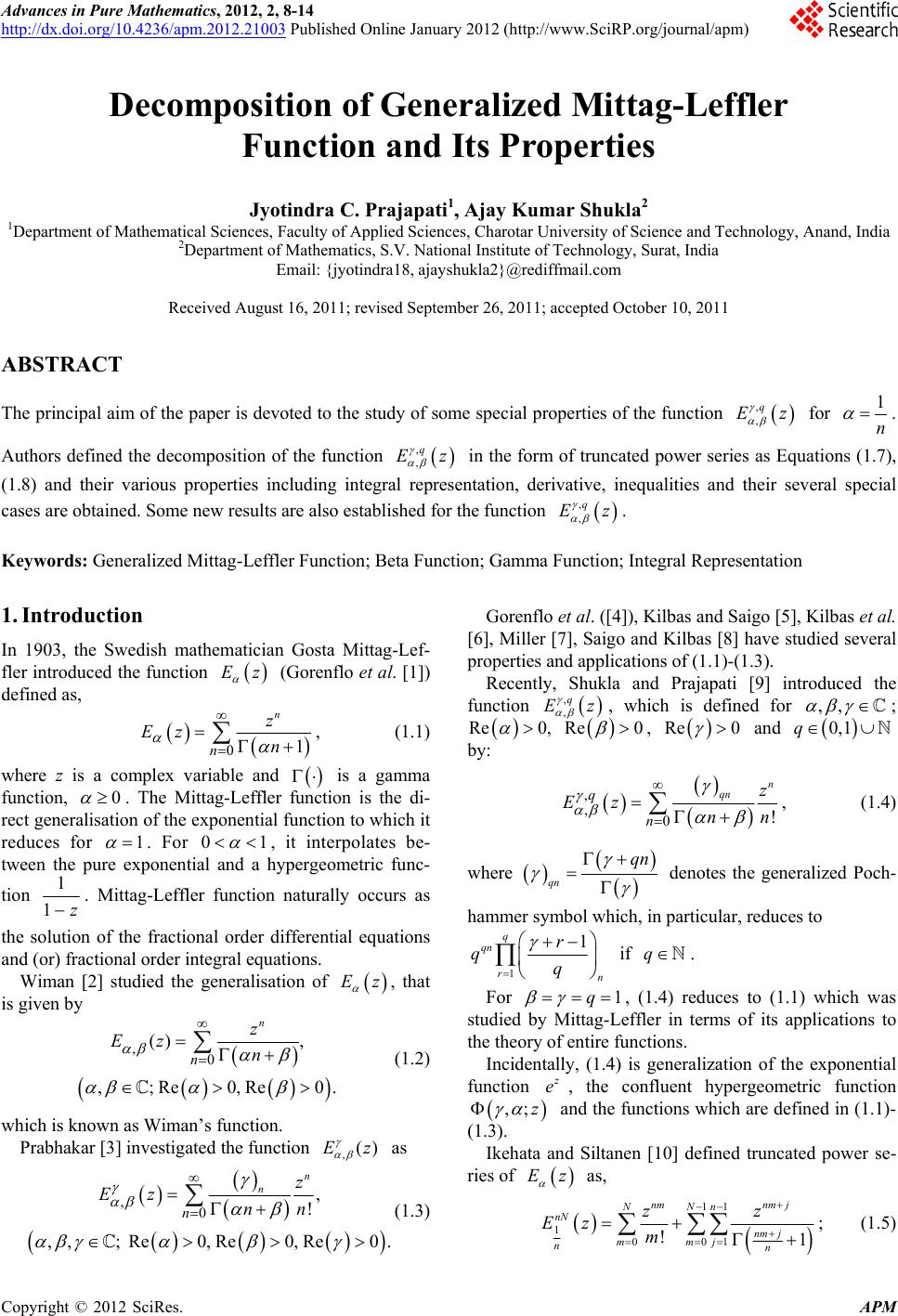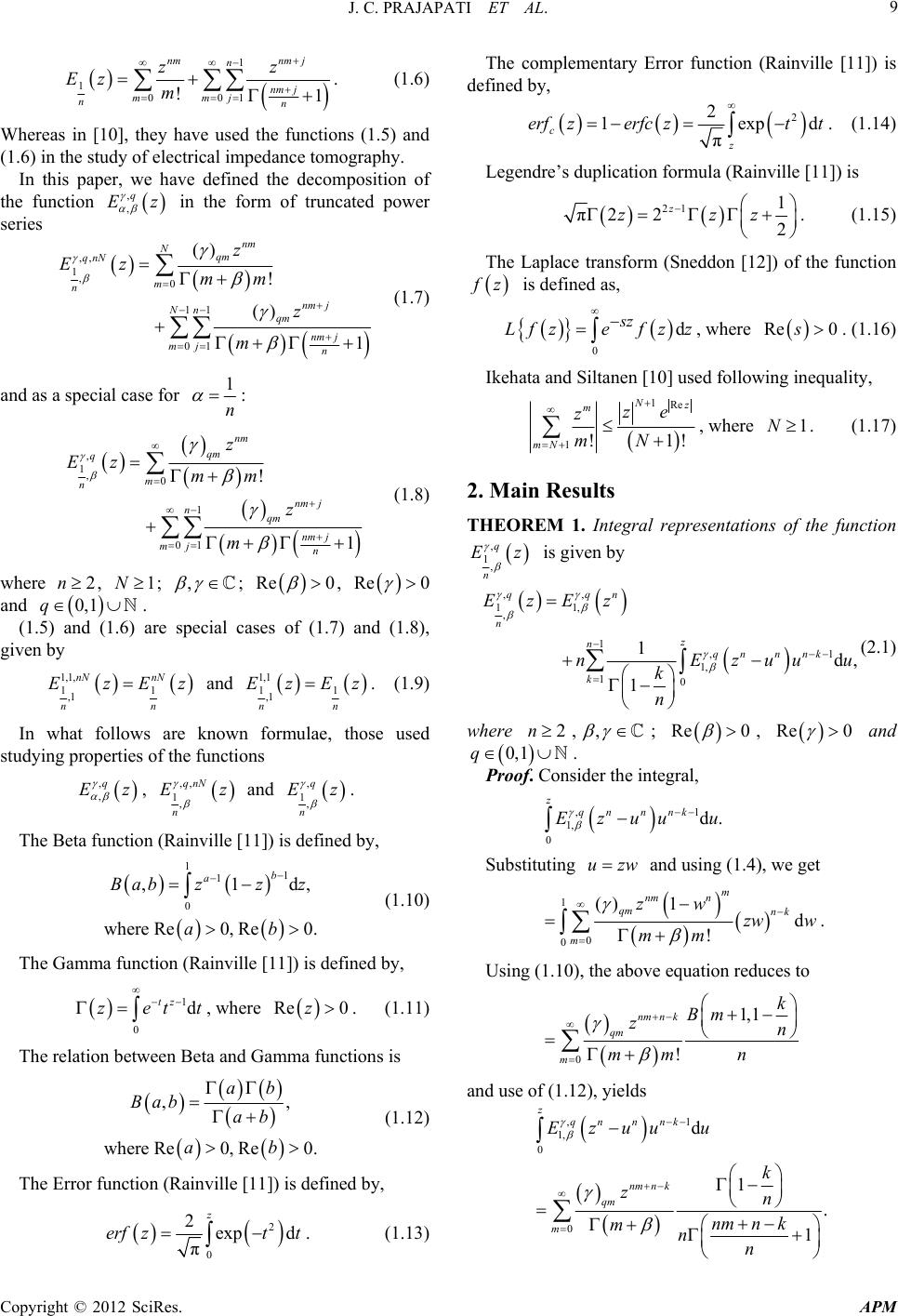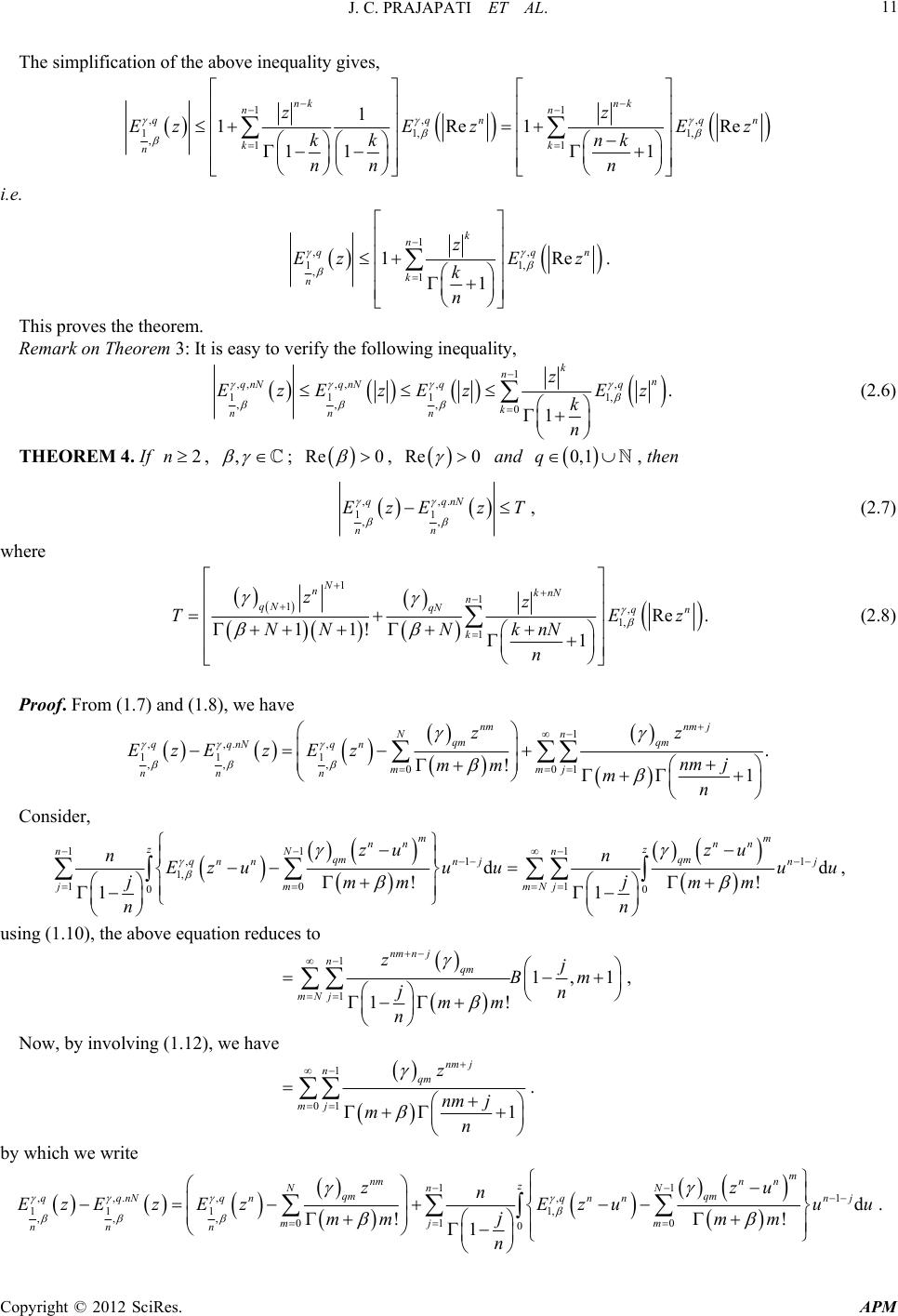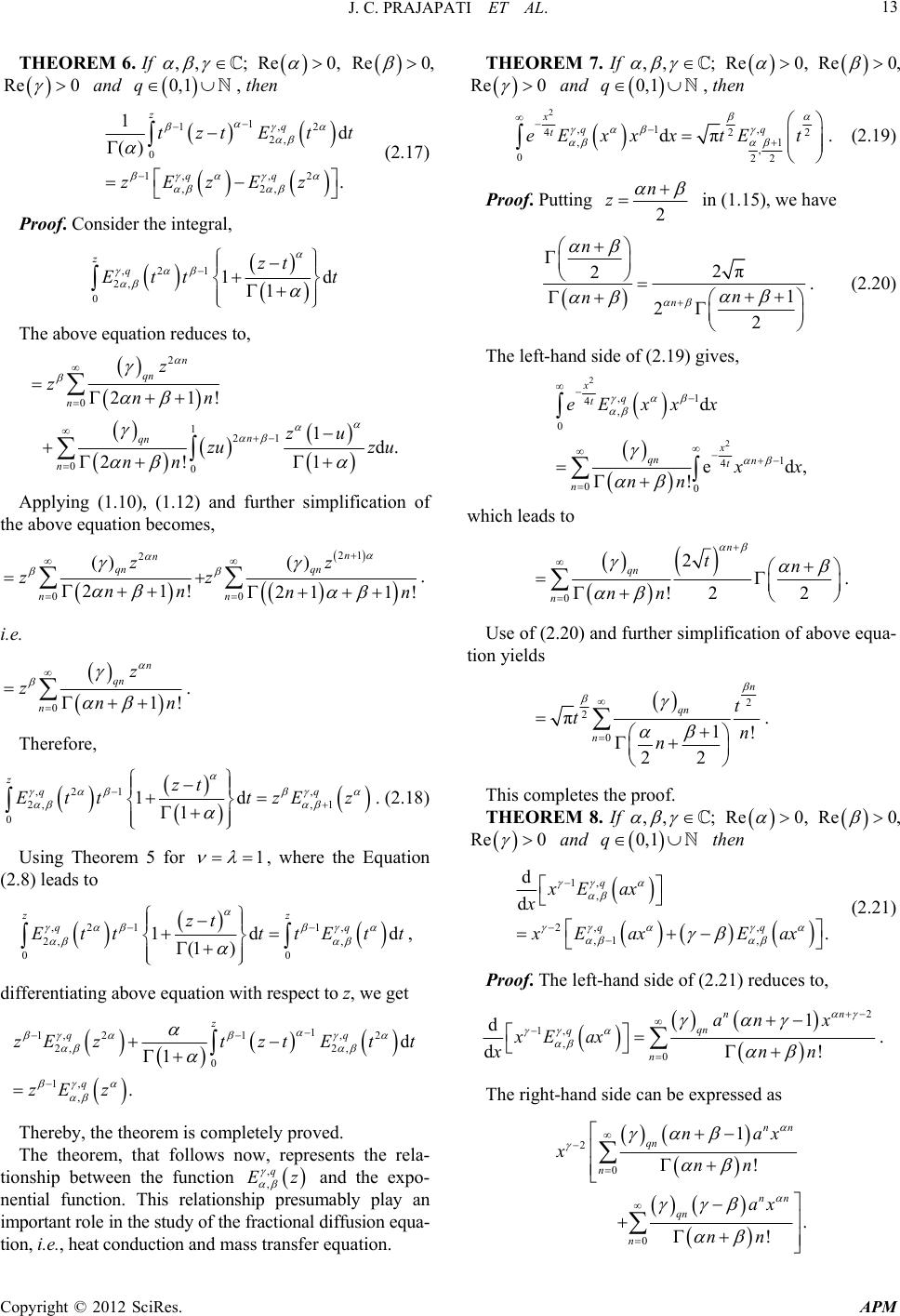 Advances in Pure Mathematics, 2012, 2, 8-14 http://dx.doi.org/10.4236/apm.2012.21003 Published Online January 2012 (http://www.SciRP.org/journal/apm) Decomposition of Generalized Mittag-Leffler Function and Its Properties Jyotindra C. Prajapati1, Ajay Kumar Shukla2 1Department of Mathematical Sciences, Faculty of Applied Sciences, Charotar University of Science and Technology, Anand, India 2Department of Mathematics, S.V. National Institute of Technology, Surat, India Email: {jyotindra18, ajayshukla2}@rediffmail.com Received August 16, 2011; revised September 26, 2011; accepted October 10, 2011 ABSTRACT The principal aim of the paper is devoted to the study of some special properties of the function for , , q E z1 n . Authors defined the decomposition of the function , , q Ez in the form of truncated power series as Equations (1.7), (1.8) and their various properties including integral representation, derivative, inequalities and their several special cases are obtained. Some new results are also established for the function , , q Ez Ez . Keywords: Generalized Mittag-Leffler Function; Beta Function; Gamma Function; Integral Representation 1. Introduction In 1903, the Swedish mathematician Gosta Mittag-Lef- fler introduced the function (Gorenflo et al. [1]) defined as, 01 n z n n Ez 0 , (1.1) where z is a complex variable and is a gamma function, . The Mittag-Leffler function is the di- rect generalisation of the exponential function to which it reduces for 1 . For 01 , it interpolates be- tween the pure exponential and a hypergeometric func- tion 1 1z. Mittag-Leffler function naturally occurs as the solution of the fractional order differential equations and (or) fractional order integral equations. Wiman [2] studied the generalisation of Ez , that is given by ,0 () ,; Re0, n Ez , Re0 . n z n ,()Ez (1.2) which is known as Wiman’s function. Prabhakar [3] investigated the function as ,0 ,, ;Re 0,Re n n Ez Gorenflo et al. ([4]), Kilbas and Saigo [5], Kilbas et al. [6], Miller [7], Saigo and Kilbas [8] have studied several properties and applications of (1.1)-(1.3). Recently, Shukla and Prajapati [9] introduced the function , , q Ez ,,, which is defined for ; Re 0 Re 0 , and Re0 , 0, 1q by: , ! 0,Re 0. n z nn (1.3) , ,0! n qn q n z Ez nn , (1.4) where qn qn denotes the generalized Poch- hammer symbol which, in particular, reduces to 1 1 q qn rn r qq q if 1q . For , (1.4) reduces to (1.1) which was studied by Mittag-Leffler in terms of its applications to the theory of entire functions. Incidentally, (1.4) is generalization of the exponential function e, the confluent hypergeometric function ,;z and the functions which are defined in (1.1)- (1.3). Ikehata and Siltanen [10] defined truncated power se- ries of Ez as, 11 1 001 !1 nmnm j NNn nN nm j mmj nn zz Ez m ; (1.5) C opyright © 2012 SciRes. APM  J. C. PRAJAPATI ET AL. 9 1 11 nm j nm j j n z , , q Ez 1 00 ! nm n mm n z Ez m . (1.6) Whereas in [10], they have used the functions (1.5) and (1.6) in the study of electrical impedance tomography. In this paper, we have defined the decomposition of the function in the form of truncated power series ,, 1,0 11 01 () ! () nm Nqm qnN m n Nn mj z Ez mm m 1 nm j qm nm j n z (1.7) and as a special case for 1 n : , 1,0 1 01 ! nm qm q m n n mj z Ez mm m 1 nm j qm nm j n z (1.8) where , ; 2nN1, ; , Re 0 Re 0 and . 0, 1q (1.5) and (1.6) are special cases of (1.7) and (1.8), given by 1 nN nn Ez 1,1, 1 ,1 nN Ez and 1,1 11 ,1 nn EzEz . (1.9) In what follows are known formulae, those used studying properties of the functions , , q Ez , ,, 1, qnN n Ez and , 1, q n Ez 1 ,1d, 0, Re0. b z z ab 1 0 tz ze Re 0z . The Beta function (Rainville [11]) is defined by, 1 1 0 where Re a Bab z (1.10) The Gamma function (Rainville [11]) is defined by, dtt, where . (1.11) The relation between Beta and Gamma functions is where Re Bab ,, 0, Re0. ab ab ab (1.12) The Error function (Rainville [11]) is defined by, 2 0 exp d zt t . (1.13) The complementary Error function (R defined by, 2 π erf z ainville [11]) is 2 1e xpd π cz erfzerfc ztt . (1.14) 2 Legendre’s duplication formula (Rainville [11]) is 21 1 π22 z zzz . (1.15) The Laplace transform (Sneddon [12]) of the function 2 z is defined as, Ikehata and Siltanen [10] used following inequality, 0 d sz Lfzefz z , where Re 0s. (1.16) 1Re N 1!1! mze z , where 1N. (1.17) 2. Main Results THEOREM 1. Integral representations of the function mN mN , 1, q n Ez is given by , 1,1 1, 10 1d, 1 n z nqn nnk k nE zuuu k n (2.1) where 2n,, ,, 11 qqn EzEz , ; Re 0 , Re 0 and 0, 1q . Proof. Consider the integral, 1 1, d. zn nnk Ezuu u Substituting uzw ,q 0 and using (1.4), we get 0 d ! m 1 0 ()1 nm n qm nk zw m zw Using (1.10), the above equation reduces to w mm . 0 1,1 nm n k m k Bm and use of (1.12), yields ! qm zn mm n ,1 1, 0 d 1 . 1 zqnnnk nm n k qm m Ezuu u k zn nm n k mnn 0 Copyright © 2012 SciRes. APM  J. C. PRAJAPATI ET AL. Copyright © 2012 SciRes. APM 10 i.e. ,1 d. nm n k nnk uu u Taking s 1, 00 11 z qm qn m znEz nm n kk mnn ummation over 1k to 1kn and using (1.8), we arrive at 11 d. z nnnnk uu u This comp , , ,, , 11, 1, ,10 1 1 qq n q k n EzEz nEz k n letes the proof of the theorem. THEOREM 2. If 2n 0, ; Re Re 0 and 0, 1q , then 111 1, 1 1,11 d d nn qn k qn kk n zE z zkm znk nn !! km nn qm n zz mn (2.2) .4) in left-hand side of (2.2), we obtain Proof. Applying (1 22 11 1, 1,11 d d1! 1! nn n qm qm 2 1! mmm n qn mmmn n zzz zE zmmm zmmm nnn mn qm . (2.3) Setting mnk in the first summation and replacing m by in second, right-hand side of (2.3) reduces to 11 . ! mm nn m n zz mn pletes the Theorem 11 10 1! nn qn k q km nk m nk nn This com proof of the theorem. Remark on 2. If 1q , then Theorem 2 leads a paar case of (2.3) rticul 11 11 ,, nn nn E z 1 11 1 d d k nn k z zE zzk z n , (2.4) w here 2n,, ; Re e 0 and 0 , R 0, 1q . ; Re 0 , Re 0 and 0, 1q THEOREM 3. If 2n, , . 1 ,, 11, ,0 Re 1 n qq n k n Ez E z k n . in (2e get k z (2.5) Proo uz .1f. Substitutingw), w 1 ,,, 1 11,1, ,10 1d 1 nk qqnqnnnk k n z EzEznEzww w k n . Therefore, 1n 1 1, 1 1, ,10 Re d 1 nk n n qnnk k n z Ez nEzww k n . ,, 11 , Re qq zE  J. C. PRAJAPATI ET AL. 11 The simplification of the above inequality gives, , 1, Re 1 qn Ez i.e. 11 ,, 11, ,11 1 1Re1 11 nk nk nn qqn kk n zz EzEz kk nk nn n 1, , ,1 Re 1 k nqn k n zE z k n . This proves the theorem. Remark on Theorem 3: It is easy to verify the following inequality, , 11 1 q Ez , 1, . n q Ez k n (2.6) 1 ,, ,,, 11 1 ,,, 01 k n qnN qnNq k nn n z EzE zEz THEOREM 4. If n2, , ; Re 0 , Re 0 and , then 0, 1q ,,. 11 qqnN EzE zT ,, nn , (2.7) where , 1, Re . qn z (2.8) Proof. From (1.7) and (1.8), we have 1 1 1 1 11 !1 N nknN n qN qN k zz TE knN NN N n 1 ,,. , 11 1 ,,,001 ! nm Nn qm qm qqnN qn mmj nnn Ez Ez Ezmm m . 1 nm j zz nmj n Consider, 11 1 ,1 1, 1 1 0 dd !! 1 mm nn nn z z nN n qm qm qn nnjnj mNj zu zu nn Ezuu uu u j mm mm , using (1.10), the above equation reduces to 10 0 1 jm j nn 1 11! nm nj nqm mNj z jmm n 1,1 j Bm n , Now, by involving (1.12), we have 1 01 nqm mj m 1 nm j z nmj n . by which we write 11 ,,. ,, 11 11, 1 010 0 d !! 1 m nmn n z Nn N qm qm qqnN qnqnnnj j m zzu n EzEz EzEzuuu j mm mm n . ,, , m nn n Copyright © 2012 SciRes. APM  J. C. PRAJAPATI ET AL. APM 12 Therefore, further we have, ,,. , 11 1 ,,, 0 11 1, 10 0 ! 1 ! 1 nm Nqm qqnN qn m ,1 d. nn m nm n z nk nN qm qn nnnk km z EzE zEzmm zw nz Ezzww w kmm n e have n Using the inequality (1.17), w , 1 , Re qn n z M , (2.9) where 1 1 ,,. 11 ,, 11 ! N n qN qqnN nn z EzE zE NN 1 11 1, ,1 0 0 1 d ! m nm n nk nN qm qn nnnk m zw nz 1 1 k Ezzww w mm . We see that, k n Copyright © 2012 SciRes. 1 1 1, 10 1, 1, 1 1 Re 1 ! 1 Re1 , !1 N nn nk nqN qn k nknN nqN qn k zw nz ,1 d , 1 , nnk Ez kNN n zk EzB kn NN n www N which on using (1.12), gives Re 0 , Re 0 , Re0 , and 0, 1q, then , 1, Re 1 qn zE z knN n . (2.10) Inequalities (2.9) and (2.10) lead to the proof of the Theorem. Remark on T1q 1 1 knN n qN k MN heorem 4. If then (2.7) lity reduces to an interesting inequa 1 11 1 kn n nN k nn Ez E z exp Re 1 Nn zz knN n ati [9] obtai . (2.11) This inequality contains Mittag-Leffler and Exponen- tial functions. Recently, Shukla and Prajapned several properties of the function , ,e M q Ez . Thittag-Leffler function Ez plays an important role in study of the ous propional calculus (Shukla and Praja- pati [13]). varierties fract THEOREM 5. If ,,, ; Re 0 , 1 1, 1, ,, 0 1d zqq tztEttzEz . (2.12) Proof. Substituting tzu in left-hand side of (2.12) and then using (1.10) and (1.12), we get the required re- sult. Special cases of Theorem 5: For Re0 , from (2.12), we obtain several particular cases as listed below: 11,1 1, 1 0 1d zt ztetzEz , (2.13) 11,1 2 1zz 2, 1 cosh dtt t zEz , (2.14) 0 11,1 2 2, 2 0 1sinh() d zt tt zEz t , (2.15) z 1 2 exp dztt z 21 ,1 1,1 0 c zerf zzE .(2.16) 1z  J. C. PRAJAPATI ET AL. 13 0, ; Re THEOREM 6. If ,, Re 0 , Re , 0 and q 0, 1 then 1 1,2 2, 1d () zq tztEt t 0 1, , 2 ,2, . qq zEzEz (2.17) Proof. Consider the integral, ,21 zqzt 2, 0 Et t 1d 1t The above equation reduces to, 2 0 121 00 21! 1 2! 1 n qn n n qn n z znn zu zu nn Applying (1.10), (1.12) and further simplifica the above equation becomes, d. z u tion of 2 2 () n n qn zz 1 00 () 21!21 1! qn nn zz nn nn . i.e. 01! nnn n qn z z . Therefore, , , 1 zqq zt EtttzEz . (2.18) Using Tr 1 ,2 1 2, 0 1d 1 heorem 5 fo , where the Equation (2.8) leads to 1, ,d qq tEtt , di ,2 1 2, 00 1d (1 ) zz zt Ett t fferentiating above equation with respect to z, we get 1 1, 21 2, 0 1, , 1 . , 2 2, d qq q zEzt ztEtt zE z reby, the theorem is completely proved. The theorem, that follows now, represents the rela- tionship betweeion , , q Ez and the expo- nential function. ionship presumably play an imin the study of the fractional diffusion equa- tion, conduction and mass transfer equation. THEOREM 7. If ,, ; Re 0 , Re 0 , Re 0 and 0, 1q, then z The n the fut This relat nc portant role i.e., heat 2 π xx t Proof. Putting ,1 , 422 ,1 , 022 d qq t eE xxEt . (2.19) 2 n z in (1.15), we have 2π 2 . (2.20 1 22 n n n n ) The left-hand side of (2.19) gives, 2 ,1 4 xq t n t 2 1 00 ed , ! x qn n 4 , 0 deExxx x nn which leads to 0 2 !22 n qn n n nn t . Use of (2.20) and further simplification of ab tion yields ove equa- 2 n t 2 0 π 1! 22 qn n tn n . This completes the proof. THEOREM 8. If ,, ; Re 0 , Re 0 , e 0 and R 0, 1q then 1, , 2, , ,1 , d d . q qq xE ax x xE axEax (2.21) Proof. The left-hand side of (2.21) reduces to, 2 1, , 0 1 d d! nn qn q n an x xE ax xnn . The right-hand side can be expressed as 2 0 0 ! . ! qn n qn n xnn ax nn 1nn nax nn Copyright © 2012 SciRes. APM  J. C. PRAJAPATI ET AL. Copyright © 2012 SciRes. APM 14 Inompleted. nt notationhe binomiheorem is Funktionen Ex ,” Acta volving (1.4), the proof is c Mathematica, Vol. 29, No. 1, In a slightly differe, tal t 1905, pp. 191-201. doi:10.1007/BF02403202 [3] T. R. Prabhakar, “A Singular Integral Equation with a Generalized Mittag-Leffler Function in the Kernel,” Yo- kohama Mathem, 1971, pp. 7-15. [4] R. Gorenflo aittag-Leffler Func- , 1q z 0! qn nn . (2.22) If 1q, then (2.22) reduces to simple bino pression (Rainville [8]) that is, n z atical Journal, Vol. 19 nd F. Mainardi, “On M mial ex-tion in Fractional Evaluation Processes,” Journal of Computational and Applied Mathematics, Vol. 118, No. 1-2, 2000, pp. 283-299. doi:10.1016/S0377-0427(00)00294-6 ,1 n nz 0! nn . 11zz [5] A. A. Kilbas and M. Saigo, “On Mittag-Leffler Type Function, Fractional Calculus Operators and Solution of Integral Equations,” Integral Transforms and Special Functions, Vol. 4, No. 4, 1996, pp. 355-370. THEOREM 9. If ,, ; Re 0, Re 0 Re , , 0 and q 0, 1 then 11 , , q tE zt , 1 q z Ls s doi:10.1080/10652469608819121 [6] A. A. Kilbas, M. Saigo and R. K. Saxena, “Generalised Mittag-Leffler Function and Generalised Fractional Cal- . (2.23) Proof. Applying (2.22) to the left-hand sid23), we get e (2. , 11 1 0 1, , 1! ! . qn qn qn n n q zz LsLs s L n tE zt 3. Acknowledgements The authors would like to thank the reviewers for their valuable suggestions to improve the quality of paper. REFERE [1] R. Gorenflo, A. A. Kilbas and S. V. Rogosin, “On th eralised Mittag-Leffler Type Function,” Integral T and Special Functions, Vol. 7, No. 3-4, 1998, pp. 215- 0nn s 1 n z s culus Operators,” Integral Transforms and Special Func- tions, Vol. 15, No. 1, 2004, pp. 31-49. doi:10.1080/10652460310001600717 [7] K. S. Miller, “The Mittag-Leffler and R Integral Transforms and Special Funcelated Functions,” tions, Vol. 1, No. 1, 1993, pp. 41-49. doi:10.1080/10652469308819007 [8] M. Saigo and A. A. Kilbas, “On Mittag-Leffler Type Function and Applications,” Integral Transforms and Special Functions, Vol. 7, No. 1-2, 1998, pp. 97-112. doi:10.1080/10652469808819189 [9] A. K. Shukla and J. C. Prajapati, “On a Generalization of Mittag-Leffler Function and Its Properties,” Journal of Mathematical Analysis and Applications, Vol. 336, No. 2, 2007, pp. 797-811. doi:10.1016/j.jmaa.20 The proof is completed. 07.03.018 [10] Impedance Tomo- graphy and Mittag-Leffler Function,” Inverse Problems, Vol. 20, No. 4, 2004, pp. 1325-1348. M. Ikehata and S. Siltanen, “Electrical doi:10.1088/0266-5611/20/4/019 [11] E. D. Rainville, “Special Functions,” The Macmillan Company, New York, 1960. [12] I. N. Sneddon, “The Use of Integral Transforms,” Ta NCES e Gen- ransforms 224. doi:10.1080/10652469808819200 [2] A. Wiman, “Uber de Fundamental Satz in der Theorie der ta McGraw-Hill Publication Co. Ltd., New Delhi, 1979. [13] A. K. Shukla and J. C. Prajapati, “On Generalized Mit- tag-Leffler Type Function and Generated Integral Opera- tor,” Mathematical Sciences Research Journal, Vol. 12, No. 12, 2008, pp. 283-290.
|